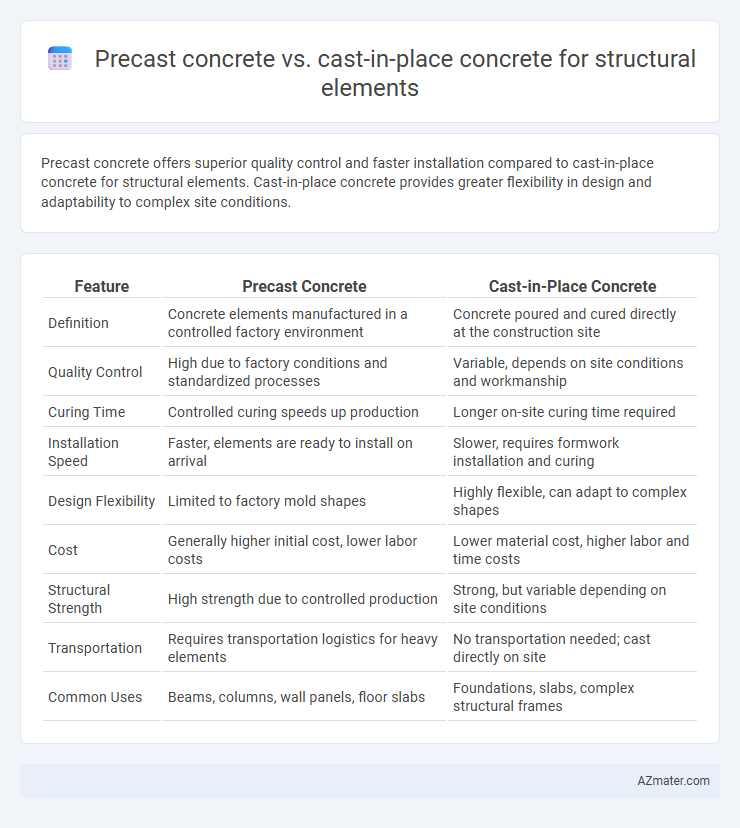Precast concrete offers superior quality control and faster installation compared to cast-in-place concrete for structural elements. Cast-in-place concrete provides greater flexibility in design and adaptability to complex site conditions.
Table of Comparison
| Feature | Precast Concrete | Cast-in-Place Concrete |
|---|---|---|
| Definition | Concrete elements manufactured in a controlled factory environment | Concrete poured and cured directly at the construction site |
| Quality Control | High due to factory conditions and standardized processes | Variable, depends on site conditions and workmanship |
| Curing Time | Controlled curing speeds up production | Longer on-site curing time required |
| Installation Speed | Faster, elements are ready to install on arrival | Slower, requires formwork installation and curing |
| Design Flexibility | Limited to factory mold shapes | Highly flexible, can adapt to complex shapes |
| Cost | Generally higher initial cost, lower labor costs | Lower material cost, higher labor and time costs |
| Structural Strength | High strength due to controlled production | Strong, but variable depending on site conditions |
| Transportation | Requires transportation logistics for heavy elements | No transportation needed; cast directly on site |
| Common Uses | Beams, columns, wall panels, floor slabs | Foundations, slabs, complex structural frames |
Introduction to Precast and Cast-in-Place Concrete
Precast concrete refers to structural elements that are manufactured and cured in a controlled factory environment before being transported to the construction site for assembly, offering advantages in quality control, speed, and reduced site labor. Cast-in-place concrete, on the other hand, is poured and cured directly at the construction site, allowing for flexible design adjustments and monolithic structures with seamless integration. Both methods are essential in modern construction, with precast concrete excelling in repetitive elements and cast-in-place concrete preferred for custom, complex geometries.
Key Differences Between Precast and Cast-in-Place Concrete
Precast concrete offers factory-controlled quality and faster installation times, reducing on-site labor and construction delays, while cast-in-place concrete provides greater flexibility for custom shapes and complex forms directly molded on-site. Precast elements are produced under controlled conditions ensuring uniform strength and durability, whereas cast-in-place concrete relies heavily on site-specific variables such as weather and workmanship, impacting curing and final strength. Maintenance and inspection of precast structures are simplified due to consistent quality, contrasting with cast-in-place concrete which may require more extensive monitoring to detect potential on-site defects or inconsistencies.
Structural Performance Comparison
Precast concrete offers superior quality control and uniformity, resulting in enhanced compressive strength and durability compared to cast-in-place concrete. Cast-in-place concrete provides better monolithic behavior and adaptability to complex shapes, improving overall structural integrity under dynamic loads. Both methods exhibit distinct advantages in load-bearing capacity and seismic performance, with selection dependent on project-specific structural requirements.
Speed of Construction and Project Timelines
Precast concrete significantly accelerates construction speed as elements are manufactured off-site under controlled conditions, allowing simultaneous site preparation and component fabrication, thus reducing overall project timelines. Cast-in-place concrete requires on-site formwork, pouring, and curing, which extends construction duration due to weather dependency and longer curing periods. Utilizing precast concrete enhances project efficiency by enabling quicker installation and minimizing delays related to on-site work variables.
Cost Analysis: Precast vs Cast-in-Place
Precast concrete typically offers lower overall labor costs due to factory-controlled conditions and faster onsite assembly, reducing construction schedules and associated expenses. Cast-in-place concrete often incurs higher costs from prolonged formwork, curing times, and labor-intensive onsite processes, especially in complex or inaccessible locations. Material costs may vary, but the efficiency gains in precast production generally lead to more predictable budgets and reduced financial risks compared to cast-in-place methods.
Quality Control and Consistency Considerations
Precast concrete offers superior quality control and consistency due to its manufacturing in a controlled factory environment, allowing for precise material batching, curing, and dimensional accuracy. Cast-in-place concrete is subject to variable on-site conditions such as weather, workmanship, and curing time, which can compromise uniformity and strength. For structural elements requiring high reliability and repeatability, precast concrete ensures better quality assurance through standardized production processes.
Design Flexibility and Architectural Applications
Precast concrete offers limited design flexibility due to standardized molds, making it ideal for repetitive and modular structural elements, whereas cast-in-place concrete excels in custom shapes and complex architectural designs. Cast-in-place concrete accommodates intricate forms and on-site modifications, supporting unique architectural features and adaptations during construction. Precast concrete enables faster installation and consistent quality but may restrict architectural creativity compared to cast-in-place methods.
Durability and Long-Term Maintenance
Precast concrete offers superior durability due to factory-controlled conditions that ensure consistent quality and reduced permeability, resulting in enhanced resistance to environmental degradation and chemical attack. Cast-in-place concrete may experience variable curing conditions on-site, potentially leading to increased porosity and reduced long-term durability, which can elevate maintenance needs. Long-term maintenance costs for precast elements are generally lower, as their uniform density and controlled reinforcement reduce risks of cracking, corrosion, and deterioration compared to cast-in-place counterparts.
Environmental Impact and Sustainability
Precast concrete significantly reduces environmental impact by minimizing on-site waste and improving quality control, which enhances durability and decreases resource consumption over the structure's lifespan. Cast-in-place concrete typically involves higher emissions due to formwork material use and prolonged curing times, contributing to increased energy use and carbon footprint on-site. Sustainability favors precast concrete as it supports recycling of molds and off-site manufacturing reduces transportation emissions, making it a greener choice for structural elements.
Choosing the Right Method for Your Project
Precast concrete offers faster installation and high quality control due to factory casting, making it ideal for projects with tight schedules and repetitive structural elements like beams, columns, and slabs. Cast-in-place concrete provides greater flexibility for custom shapes and on-site adjustments, suitable for complex designs or when transportation of large precast components is challenging. Evaluating factors such as project timeline, design complexity, site accessibility, and budget helps determine the optimal structural concrete method for your construction needs.

Infographic: Precast concrete vs Cast-in-place concrete for Structural element
 azmater.com
azmater.com